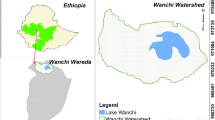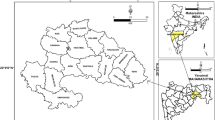Abstract
A land classification and resources inventory of Falcón State was undertaken with the aim of gathering baseline information to help in development planning. The study area, located in northwestern Venezuela, comprises an ecologically diverse region, due both to its varied geomorphology and to its history of human occupation. A landscape approach was used. On the basis of photointerpretation, examination of existing literature, and field work, uniform land units (physiognomic units) were delineated and described in terms of landform, soil, vegetation, drainage pattern, and climate. These were grouped in homogeneous units (HU) on the basis of their potential natural vegetation through the delimitation of climax complexes. The last hierarchy, the land systems, comprise the geomorphogenetically related HU. The results are presented at different levels of generalization and integration, in verbal and cartographic descriptions, and they are stored in standardized formats to ensure ease of comprehension and handling and to meet different needs. This report describes the methods employed for the survey and data presentation, and discusses its applicability and limitations.
Similar content being viewed by others
Literature cited
Beckett, P. H. T., R. Webster, G. M. McNeil and C. W. Mitchell. 1972. Terrain evaluation by means of a data bank.Geographical Journal 138:430–456.
Christian, C. S. 1952. Regional land surveys.Journal of the Australian Institute of Agricultural Sciences 18:140–146.
Christian, C. S. 1958. The concepts of land units and land systems. Proceedings of the Ninth Pacific Science Congress 20:74–81.
Christian, C. S., and G. A. Stewart. 1953. General report on survey of Katherine-Darwin Region, 1946. CSIRO Australian Land Research Series, no. 1.
Christian, C. S., and G. A. Stewart. 1968. Methodology of integrated surveys. Pages 233–280in Aerial surveys and integrated studies. Proceedings of the Toulouse Conference. UNESCO, Paris.
Cooke, R. U. 1977. Applied geomorphological studies in deserts: a review of examples. Pages 183–225in J. R. Hails (ed.), Applied geomorphology. Elsevier, New York.
COPLANARH. 1975. Inventario Nacional de Tierras. Ministerio de Agricultura y Cría, Caracas, Venezuela.
FAO. 1976. Cadre pour l'évaluation des sols.Bulletin Pedologique no. 32. Organisation des Nations Unies pour l'alimentation et l'agriculture, Rome.
Fosberg, F. R. 1967. Classification of vegetation for general purposes. Pages 73–120in G. F. Peterken (ed.), Guide to check sheet for IBP areas. IBP handbook no. 4. Blackwell, Oxford.
Jurdant, M., V. Gerardin, and L. J. Bélair. 1974. Ecological land survey, the biophysical basis of land-use planning. Pages 140–143in Structure, function and management of ecosystems. Proceedings of the First International Congress of Ecology, The Hague, 1974. Centre for Agricultural Publishing and Documentation, Wageningen, The Netherlands.
Lahey, J. F. 1973. On the origin of the dry climate in northern South America and the southern Caribbean. Pp. 75–90in D. H. K. Amiran and A. W. Wilson (eds.), Coastal deserts: their natural and human environments. University of Arizona Press, Tucson.
Mabbutt, J. A. 1968. Review of concepts of land evaluation. pages 11–28in G. A. Stewart (ed.), Land evaluation. Macmillan, Victoria, Australia.
Mueller-Dombois, D., and H. Ellenberg. 1974. Aims and methods of vegetation ecology. John Wiley and Sons, New York.
Satyanarayan, Y., and V. V. Dhruvanarayan. 1968. Use of aerial photographs in surveying ground water and vegetation resources in the arid zone of India. pages 505–508in Aerial surveys and integrated studies. Proceedings of the Toulouse Conference. UNESCO, Paris.
Shimwell, D. W. 1971. The description and classification of vegetation. Sidgwick and Jackson, London.
Stewart, G. A. (ed.). 1968. Land evaluation. Macmillan, Australia. Victoria.
UNESCO (ed.). 1968. Aerial surveys and integrated studies. Proceedings of the Toulouse Conference. UNESCO, Paris.
Walter, H., E. Harnickell, and D. Mueller-Dombois. 1975. Climate diagram maps of the individual continents and the ecological climatic regions of the earth. Springer-Verlag, New York.
Westhoff, V., and E. van der Maarel. 1978. The Braun-Blanquet approach. Pages 287–399in R. H. Whittaker (ed.), Classification of plant communities. Dr. W. Junk, The Hague.
Whittaker, R. H. 1978. Dominance-types. Pages 65–79in R. H. Whittaker (ed.), Classification of plant communities. Dr. W. Junk, The Hague.
Author information
Authors and Affiliations
Rights and permissions
About this article
Cite this article
Matteucci, S.D., Colma, A. & Pla, L. Multiple-purposes land mapping and resources inventory. Environmental Management 9, 231–242 (1985). https://doi.org/10.1007/BF01867079
Issue Date:
DOI: https://doi.org/10.1007/BF01867079




